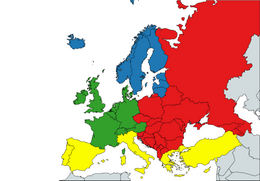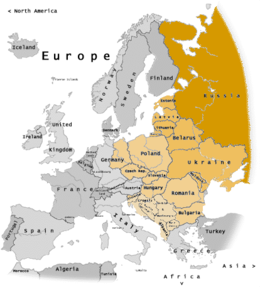
Eastern Europe is a subregion of the European continent. As a largely ambiguous term, it has a wide range of geopolitical, geographical, ethnic, cultural, and socio-economic connotations. Its eastern boundary is marked by the Ural Mountains, whilst its western boundary is defined in various ways. Most definitions include the countries of Belarus, Russia, Ukraine, Moldova and Romania while less restrictive definitions may also include some or all of the Visegrád group, the Baltic states, the Balkans and the Caucasus.

The Baltic states or the Baltic countries is a geopolitical term encompassing Estonia, Latvia, and Lithuania. All three countries are members of NATO, the European Union, the Eurozone, and the OECD. The three sovereign states on the eastern coast of the Baltic Sea are sometimes referred to as the "Baltic nations", less often and in historical circumstances also as the "Baltic republics", the "Baltic lands", or simply the Baltics.
Europe, the westernmost portion of Eurasia, is often divided into regions and subregions based on geographical, cultural or historical factors. Since there is no universal agreement on Europe's regional composition, the placement of individual countries may vary based on criteria being used. For instance, the Balkans is a distinct geographical region within Europe, but individual countries may alternatively be grouped into South-eastern Europe or Southern Europe.

The politics of Europe deals with the continually evolving politics within the continent of Europe. It is a topic far more detailed than other continents due to a number of factors including the long history of nation states in the region as well as the modern day trend towards increased political unity amongst the European states.
Territorial changes of the Baltic states refers to the redrawing of borders of Lithuania, Latvia and Estonia after 1940. The three republics, formerly autonomous regions within the former Russian Empire and before that of former Polish–Lithuanian Commonwealth and as provinces of the Swedish Empire, gained independence in the aftermath of World War I and the Russian Revolution of 1917. After a two-front independence war fought against both Bolshevist Russian and Baltic German nationalist forces, the countries concluded peace and border treaties with Soviet Russia in 1920. However, with World War II and the occupation and annexation of these republics into the Soviet Union twenty years after their independence, certain territorial changes were made in favour of the Russian SFSR. This has been the source of political tensions after they regained their independence with the dissolution of the Soviet Union. Some of the disputes remain unresolved.
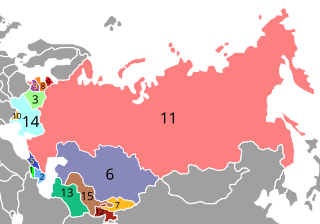
The post-Soviet states, also referred to as the former Soviet Union (FSU) or the former Soviet republics, are the independent sovereign states that emerged/re-emerged out of the dissolution of the Soviet Union in 1991. Prior to their independence, they existed as Union Republics, which were the top-level constituents of the Soviet Union. There are 15 post-Soviet states in total: Armenia, Azerbaijan, Belarus, Estonia, Georgia, Kazakhstan, Kyrgyzstan, Latvia, Lithuania, Moldova, Russia, Tajikistan, Turkmenistan, Ukraine, and Uzbekistan. Each of these countries succeeded their respective Union Republics: the Armenian SSR, the Azerbaijan SSR, the Byelorussian SSR, the Estonian SSR, the Georgian SSR, the Kazakh SSR, the Kirghiz SSR, the Latvian SSR, the Lithuanian SSR, the Moldavian SSR, the Russian SFSR, the Tajik SSR, the Turkmen SSR, the Ukrainian SSR, and the Uzbek SSR. In Russia, the term "near abroad" is sometimes used to refer to the post-Soviet states other than Russia.

Russians in the Baltic states is a broadly defined subgroup of the Russian diaspora who self-identify as ethnic Russians, or are citizens of Russia, and live in one of the three independent countries – Estonia, Latvia, and Lithuania. As of 2021, there were nearly 900,000 ethnic Russians in the three countries, having declined from ca 1.7 million in 1989, the year of the last census during the 1944–1991 Soviet occupation of the three Baltic countries.

Relations between the European Union (EU) and Moldova are currently shaped via the European Neighbourhood Policy (ENP), an EU foreign policy instrument dealing with countries bordering its member states.
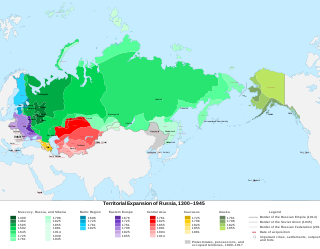
The borders of Russia changed through military conquests and by ideological and political unions in the course of over five centuries (1533–present).
The Adapted Conventional Armed Forces in Europe Treaty is a post–Cold War adaptation of the Treaty on Conventional Armed Forces in Europe (CFE), signed on November 19, 1999, during the Organization for Security and Co-operation in Europe's (OSCE) 1999 Istanbul summit. The main difference with the earlier treaty is that the troop ceilings on a bloc-to-bloc basis would be replaced with a system of national and territorial ceilings. Furthermore, the adapted treaty would provide for more inspections and new mechanisms designed to reinforce States Parties’ ability to grant or withhold consent for the stationing of foreign forces on their territory.

The Community for Democracy and Rights of Nations, also commonly and colloquially known as the Commonwealth of Unrecognized States, rarely as CIS-2, is an international organization in Eastern Europe and the South Caucasus of three breakaway states in the territory of the former Soviet Union, all of which have limited to no recognition from the international community.
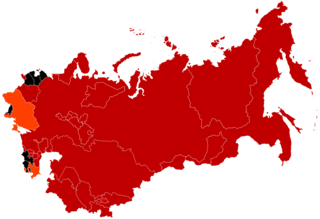
The New Union Treaty was a draft treaty that would have replaced the 1922 Treaty on the Creation of the USSR to salvage and reform the Soviet Union. A ceremony of the Russian SFSR signing the treaty was scheduled for 20 August 1991, but was prevented by the August Coup a day earlier. The preparation of this treaty was known as the Novo-Ogaryovo process, named after Novo-Ogaryovo, a governmental estate where the work on the document was carried out and where Soviet President and CPSU General Secretary Mikhail Gorbachev talked with leaders of Union republics.

The three Baltic countries, or the Baltic states – Estonia, Latvia, and Lithuania – are held to have continued as legal entities under international law while under the Soviet occupation from 1940 to 1991, as well as during the German occupation in 1941–1944/1945. The prevailing opinion accepts the Baltic thesis of illegal occupation and the actions of the USSR are regarded as contrary to international law in general and to the bilateral treaties between the USSR and the three Baltic countries in particular.

An independence referendum was held in the Republic of Georgia on 31 March 1991. It was approved by 99.5% of voters.

International recognition of Transnistria – a disputed region in Eastern Europe located between Moldova and Ukraine – is controversial. Although Transnistria declared independence in 1990, no United Nations member recognises its sovereignty and the region is considered by the UN to be part of Moldova. Currently, only Abkhazia, the Republic of Artsakh and South Ossetia recognise its independence, all themselves states with limited recognition. Despite not officially recognizing Transnistria's independence, Russia has close relations with Transnistria and even established a consulate in the territory. The Council of Europe considers the region a Russian-occupied territory.

Russian-occupied territories in Georgia are areas of Georgia that have been occupied by Russia after the Russo-Georgian War in 2008. They consist of the regions of the Autonomous Republic of Abkhazia and the former South Ossetian Autonomous Region of Soviet Georgia, whose status is a matter of international dispute.

Cooperation between China and Central and Eastern European Countries is an initiative by the Chinese Ministry of Foreign Affairs to promote business and investment relations between China and 14 countries of Central and Eastern Europe : Albania, Bosnia and Herzegovina, Bulgaria, Croatia, the Czech Republic, Greece, Hungary, Montenegro, North Macedonia, Poland, Romania, Serbia, Slovakia, and Slovenia. Prior to their 2022 withdrawal, Estonia, Latvia, and Lithuania were members of the initiative.

Since the dissolution of the Soviet Union in 1991, Russia has been involved in territorial disputes with a number of other post-Soviet states. These disputes are primarily an aspect of the post-Soviet conflicts, and have led to some countries losing parts of their sovereign territory to what a large portion of the international community designates as a Russian military occupation. As such, these lands are commonly described as Russian-occupied territories, regardless of what their status is in Russian law. The term is applied to Georgia, Moldova, and Ukraine.
The road signs in the post-Soviet states Armenia, Azerbaijan, Belarus, Estonia, Georgia, Kazakhstan, Kyrgyzstan, Latvia, Lithuania, Moldova, Russia, Tajikistan, Turkmenistan, Ukraine and Uzbekistan are largely similar to the Soviet road sign system, as these countries were part of the Soviet Union until its dissolution in 1991. However, in some countries of the former USSR, some road signs may look different from the Soviet ones. The Soviet Union was a signatory to the 1968 Vienna Convention on Road Signs and Signals. After the dissolution of the Soviet Union in 1991, most of the post-Soviet states adopted their own road sign standards. Many of them use road sign systems that inherited the road sign system used in the Soviet Union before 1991, but with some modifications, except for Estonia and Latvia that use completely different road sign systems. Estonia and Latvia have their own road sign systems, which are very different in design from the Soviet one. Modern road signs in Armenia, Azerbaijan, Belarus, Estonia, Georgia, Kazakhstan, Kyrgyzstan, Latvia, Lithuania, Moldova, Russia, Tajikistan, Turkmenistan, Ukraine and Uzbekistan comply with the Vienna Convention on Road Signs and Signals as well as most European countries. Of the 15 former post-Soviet states, only Belarus, Russia and Ukraine have signed and ratified the Vienna Convention on Road Signs and Signals on behalf of the Soviet socialist republics. These 3 countries have ratified this convention on June 18, 1974.
